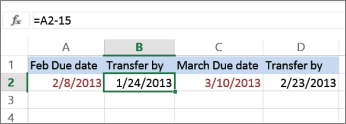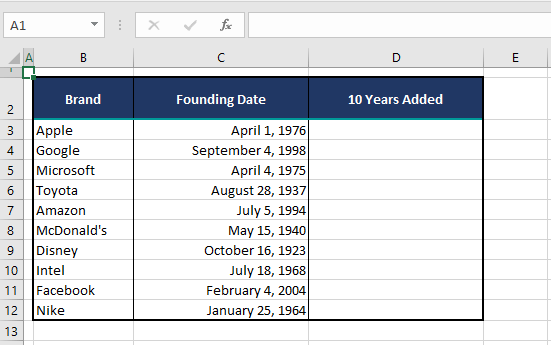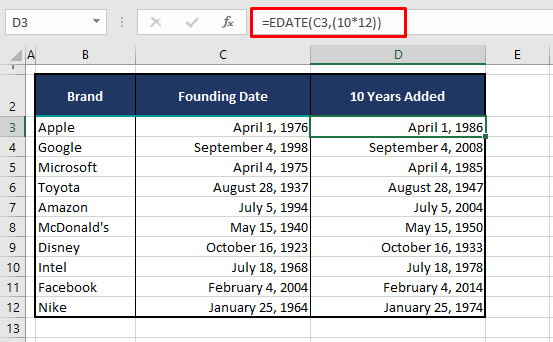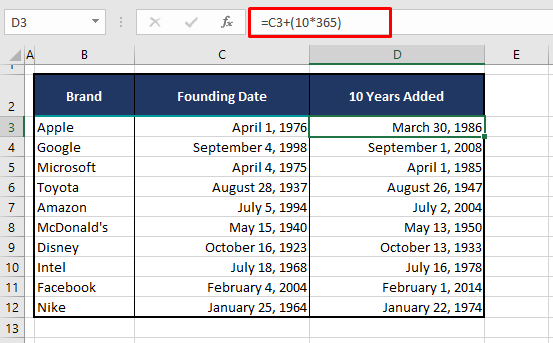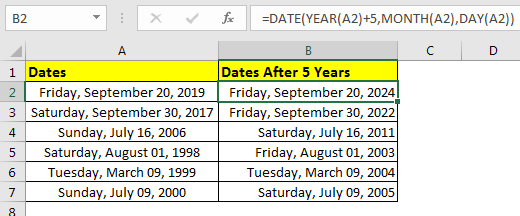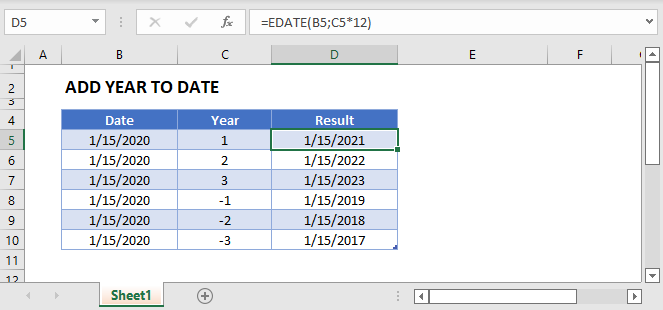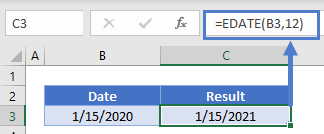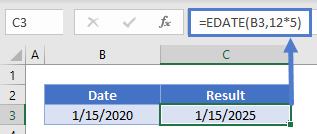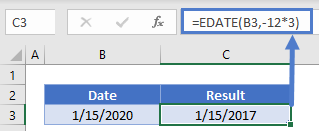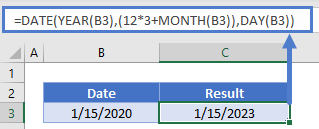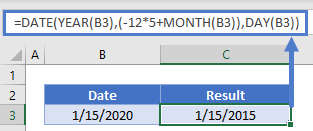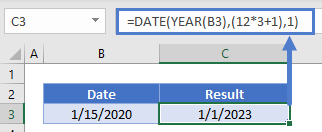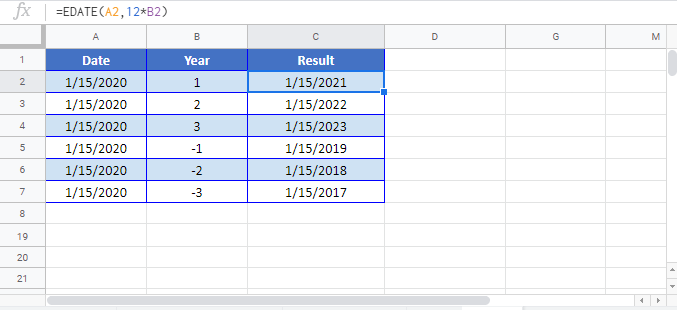Add or subtract days from a date
Suppose that a bill of yours is due on the second Friday of each month. You want to transfer funds to your checking account so that those funds arrive 15 calendar days before that date, so you’ll subtract 15 days from the due date. In the following example, you’ll see how to add and subtract dates by entering positive or negative numbers.
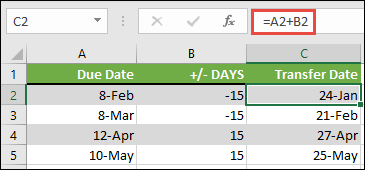
-
Enter your due dates in column A.
-
Enter the number of days to add or subtract in column B. You can enter a negative number to subtract days from your start date, and a positive number to add to your date.
-
In cell C2, enter =A2+B2, and copy down as needed.
Add or subtract months from a date with the EDATE function
You can use the EDATE function to quickly add or subtract months from a date.
The EDATE function requires two arguments: the start date and the number of months that you want to add or subtract. To subtract months, enter a negative number as the second argument. For example, =EDATE(«9/15/19»,-5) returns 4/15/19.
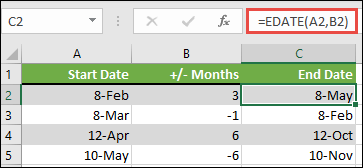
-
For this example, you can enter your starting dates in column A.
-
Enter the number of months to add or subtract in column B. To indicate if a month should be subtracted, you can enter a minus sign (-) before the number (e.g. -1).
-
Enter =EDATE(A2,B2) in cell C2, and copy down as needed.
Notes:
-
Depending on the format of the cells that contain the formulas that you entered, Excel might display the results as serial numbers. For example, 8-Feb-2019 might be displayed as 43504.
-
Excel stores dates as sequential serial numbers so that they can be used in calculations. By default, January 1, 1900 is serial number 1, and January 1, 2010 is serial number 40179 because it is 40,178 days after January 1, 1900.
-
If your results appear as serial numbers, select the cells in question and continue with the following steps:
-
Press Ctrl+1 to launch the Format Cells dialog, and click the Number tab.
-
Under Category, click Date, select the date format you want, and then click OK. The value in each of the cells should appear as a date instead of a serial number.
-
-
Add or subtract years from a date
In this example, we’re adding and subtracting years from a starting date with the following formula:
=DATE(YEAR(A2)+B2,MONTH(A2),DAY(A2))
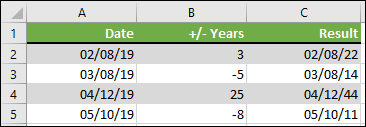
How the formula works:
-
The YEAR function looks at the date in cell A2, and returns 2019. It then adds 3 years from cell B2, resulting in 2022.
-
The MONTH and DAY functions only return the original values from cell A2, but the DATE function requires them.
-
Finally, the DATE function then combines these three values into a date that’s 3 years in the future — 02/08/22.
Add or subtract a combination of days, months, and years to/from a date
In this example, we’re adding and subtracting years, months and days from a starting date with the following formula:
=DATE(YEAR(A2)+B2,MONTH(A2)+C2,DAY(A2)+D2)

How the formula works:
-
The YEAR function looks at the date in cell A2, and returns 2019. It then adds 1 year from cell B2, resulting in 2020.
-
The MONTH function returns 6, then adds 7 to it from cell C2. This gets interesting, because 6 + 7 = 13, which is 1-year and 1-month. In this case, the formula will recognize that and automatically add another year to the result, bumping it from 2020 to 2021.
-
The DAY function returns 8, and adds 15 to it. This will work similarly to the MONTH portion of the formula if you go over the number of days in a given month.
-
The DATE function then combines these three values into a date that is 1 year, 7 months, and 15 days in the future — 01/23/21.
Here are some ways you could use a formula or worksheet functions that work with dates to do things like, finding the impact to a project’s schedule if you add two weeks, or time needed to complete a task.
Let’s say your account has a 30-day billing cycle, and you want to have the funds in your account 15 days before the March 2013 billing date. Here’s how you would do that, using a formula or function to work with dates.
-
In cell A1, type 2/8/13.
-
In cell B1, type =A1-15.
-
In cell C1, type =A1+30.
-
In cell D1, type =C1-15.
Add months to a date
We’ll use the EDATE function and you’ll need the start date and the number of months you want to add. Here’s how to add 16 months to 10/24/13:
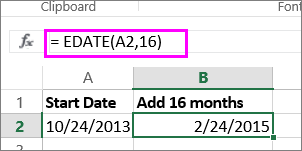
-
In cell A1, type 10/24/13.
-
In cell B1, type =EDATE(A1,16).
-
To format your results as dates, select cell B1. Click the arrow next to Number Format, > Short Date.
Subtract months from a date
We’ll use the same EDATE function to subtract months from a date.
Type a date in Cell A1 and in cell B1, type the formula =EDATE(4/15/2013,-5).

Here, we’re specifying the value of the start date entering a date enclosed in quotation marks.
You can also just refer to a cell that contains a date value or by using the formula =EDATE(A1,-5)for the same result.
More examples
To add years to or subtract years from a date

|
Start Date |
Years added or subtracted |
Formula |
Result |
|---|---|---|---|
|
10/24/2013 |
3 (add 3 years) |
=DATE(YEAR(A2)+B2,MONTH(A2),DAY(A2)) |
10/24/2016 |
|
10/24/2013 |
-5 (subtract 5 years) |
=DATE(YEAR(A4)+B4,MONTH(A4),DAY(A4)) |
10/24/2008 |
Hi reader, here it is again; Excel shorty logging in. Do you know how to add years to a date in Excel? No? Keep reading. We are back with a quick lesson on 3 quick methods to add years to dates. The three methods we will use to add years are: easy, peasy, and lemon squeezy.
In Excel terms, We mean that the 3 methods are usage of the EDATE function, the YEAR and DATE functions, and a simple custom formula.
For calculations and data analysis, you may need to add years to a date to arrive at a later or future date or deduct years to arrive at an earlier date. We can show you how to do that with the help of our assistant.
Example
Our humble assistant today is the represented example case. We have a selection of longstanding successful brands in column B and, let’s say, would like to analyze their revenue after 10 years of company founding. For that, first, we need to add 10 years to each of their founding dates in column C:
We see you’re accusing us of incomplete homework but that’s what we’re here to remedy today. We will show you how to fill column D by adding 10 years to each of the founding dates using various formulas. Before we rush to the hows, jot down a few notes:
Notes:
If you start right away, using any formula to fill column D, for the first instance, you will get «31503». Just so you don’t think your meticulously typed formula hasn’t worked, we advise changing the format of the column beforehand because the default format of the cells is the General format and dates require a date format if you don’t want the result as a serial number. What would be even better is if you select both columns C and D and set the same format for both so that the dates in both columns are far more easily comparable. To change the format, you can use the Number Format bar in the Home tab or select one of many date format options from the Format Cells dialog box, accessed by pressing the Ctrl + 1 keys.
Question: Why would we get «31503» in General format instead of a date?
Answer: Excel stores dates as serial numbers (1 being January 1, 1900), and dates would appear so, resultant of formulas, unless the format of the cells is changed to a date format.
Similar to adding, years can be subtracted from a date by a simple minus sign tweak in the formulas.
In our demonstrations below, we have added a flat value of 10 in each formula since we want to add 10 years to every date. If you have a column with different numbers of years to add to the dates, you’ll need to replace the number 10 in the formulas with the reference of the cell with the number of years. We’ll show you a small example below.
Let’s get adding!
Using EDATE Function
Let’s check out our first method which is using the EDATE function for adding years to a date in Excel. The EDATE function adds or deducts the supplied number of months from a date and returns it as a serial number.
Whatever you will do with a serial number when you want a date? Well, that serial number is the date, as we have just explained above. With some numerical confusion cleared, we can move onto the formula that involves the EDATE function to add years to a date. Here it is:
=EDATE(C3,(10*12))
With the dates listed in column C, the EDATE function takes C3 as its working date. The next argument is the number of months that will be added to the date. Here we have entered 10*12 to add years instead of months. This adds 10 years to April 1, 1976 and returns April 1, 1986.
Make sure you have the format of the target column changed into a date format as per your preference. Now let’s apply the formula to the rest of the dates:
Note: Without multiplying the number with 12 in the formula, it will add months to the date.
We promised you a small example of adding a different number of years to the dates. Here it is; see the example below and the formula just ahead:
=EDATE(C3,(D3*12))
The only difference from the previous formula is that the number 10 has been swapped with the reference of the cell containing the number of years to be added i.e. D3. In this way, the number of years in column D will be added to the dates in column C:
Using YEAR & DATE Functions
The YEAR function can be nested in the DATE function to add years to a date. The YEAR function returns the year of a given date between 1900 and 9999. The DATE function takes an argument each for the year, month and day and returns the collated date as the relevant serial number.
The YEAR function is not the only function that will be used with the DATE function to coin this formula. The MONTH and DAY functions will be used like the YEAR function to return a complete date. We’ll show you how it’s done using the following formula that enlists the YEAR and DATE function to add years to a date:
=DATE(YEAR(C3)+10,MONTH(C3),DAY(C3))
The YEAR, MONTH, and DAY functions take the year, month, and day respectively from the date in C3, as required by the DATE function to return a date. The only difference is that the number 10 has been added to the YEAR function to add 10 years to the date in C3. The addition successfully adds the mentioned years to all the dates in our example:
Note: Similarly, numbers can be added to the MONTH and DAY arguments of this formula to add the supplied number of months or days to the date.
Custom Formula
If you want to strip the formula down, excluding any functions, it is possible to add years to a date in Excel using simple arithmetic. See the formula below and then let’s show you the small problem with it:
=C3+(10*365)
A year of 365 days has been multiplied by 10 since we want to add 10 years, and added to the date in C3. Have you figured out the loophole here? See the results of this formula below for our example case:
The days in the new dates differ from the original dates. Why? The years are added in the formula assuming each year is a 365-day year. That is obviously impractical as it does not account for leap years. This method is will, however, be better applicable for adding a fixed number of days to a date.
That was our little lesson on how to add years to a date in Excel using 3 easy formulas. You see how effortless and quick that was? We have more handpicked, ripe, and ready, simple techniques for your Excel life but we’ll need a teensy bit of time to prep it for you. Excel shorty logging out!
If you want to add years to a date in excel, you can’t just simply do an addition to add years. If you add 1 year as a number to a date, it wil add 1 day. In excel, 1 is equal to 1 day (24 hours). If you add multiples of 365 to a given date then it will give an incorrect answer, since there can be a leap year in between. To add years to a date in excel, we use a formula.
Generic Formula
=DATE(YEAR(date)+num_years, MONTH(date),DAY(date))
Date: the date in which you want to add years.
Num_years: the number of years you want to add.
Example: Add 5 Years to Start Date.
Here we have some dates. In each date we need to add five years.
Write this formula in cell B2 and copy it down the rows.
This returns a date 5 years ahead of start date.
How it works?
It’s simple. We extracted year, month and date from date using function of same name. Added 5 to years YEAR(A2)+5. And then integrated year, month and date using DATE function of excel. This gave us a new date of 5 years ahead.
How to subtract years from date?
Just replace the addition sign with subtraction sign (“-”) subtract years from a date.
Above formula will give you a date exact 5 years before.
So yeah guys, this how you can add years to a date in excel easily. In example I have used hardcoded years. You can also give reference of cell so that it can be dynamic. Let me know if you have any query regarding this or any other topic of Excel and VBA.
Related Articles:
Add Months to a Date
Calculate years between dates
Calculate days, years and months from certain date
Calculate age from date of birth
Calculate Minutes Between Dates & Time In Microsoft Excel
Calculate Months Between dates in Excel
Popular Articles
50 Excel Shortcut to Increase Your Productivity: Get faster at your task. These 50 shortcuts will make you work even faster on Excel.
How to use the VLOOKUP Function in Excel: This is one of the most used and popular functions of excel that is used to lookup value from different ranges and sheets.
How to use the COUNTIF function in Excel: Count values with conditions using this amazing function. You don’t need to filter your data to count specific values. Countif function is essential to prepare your dashboard.
How to use the SUMIF Function in Excel: This is another dashboard essential function. This helps you sum up values on specific conditions.
Return to Excel Formulas List
Download Example Workbook
Download the example workbook
This tutorial will demonstrate how to add (or subtract) years to a date in Excel and Google Sheets.
Add Years to a Date
The easiest way to add years to a date is with the EDATE Function. The EDATE Function adds a specified number of months to a date. By adding months in multiplies of 12 (12,24,36, etc.) you can add years to a date.
Add 1 Year to a Date
This example will add 1 year to a date:
=EDATE(B3,12)Add 5 Years to a Date
This example will add 5 years to a date:
=EDATE(B3,12*5)Subtract Years From a Date
To subtract years from a date, simply enter a negative number of months into the EDATE Function:
=EDATE(B3,-12*3)Add Years with DATE Function
Another way to add years to a date is with the YEAR, MONTH, DAY and DATE Functions:
=DATE(YEAR(B3),(12*3+MONTH(B3)),DAY(B3))The DATE Function creates a date using a specified Year, Month, and Day. We populate the DATE function with the current date’s year, month + a number of months and day using the YEAR, MONTH, and DAY Functions.
Subtract Years with DATE Function
Of course the same logic applies with subtracting dates:
=DATE(YEAR(B3),(-12*5+MONTH(B3)),DAY(B3))Add Years – First Day of New Year
To add years to a date and return the first day of the calculated year, you can also use the DATE Function:
=DATE(YEAR(B3),(12*3+1),1)Add / Subtract Years in Google Sheets
The above examples work exactly the same in Google Sheets as in Excel:
How to subtract or add years to date in Excel
- To add years to a date in Excel: =DATE(YEAR(A2) + 5, MONTH(A2), DAY(A2)) The formula adds 5 years to the date in cell A2.
- To subtract years from a date in Excel: =DATE(YEAR(A2) – 5, MONTH(A2), DAY(A2)) The formula subtracts 5 years from the date in cell A2.
Contents
- 1 How do you increment a year by one in Excel?
- 2 How do you add a month and year in Excel?
- 3 How do I use the Datedif function in Excel?
- 4 How do I add 1.5 months to a date in Excel?
- 5 How do I combine dates and months in Excel?
- 6 How do I get the month and year from a date in Excel?
- 7 How do you extend years in Excel?
- 8 How do I calculate years from a date in Excel?
- 9 How do I convert birthdate to age in Excel?
- 10 How do I calculate age from a specific date in Excel?
- 11 How do I add 3 years to a date in Excel?
- 12 How do you calculate 12 months from a date?
- 13 Which data function is used to add calendar months to date?
- 14 Why won’t excel group my dates?
- 15 How do you group dates into months in Excel?
- 16 How do I increase the date and time in Excel?
- 17 How do I auto populate a date?
- 18 How do I calculate age in mm/dd/yyyy in Excel?
How do you increment a year by one in Excel?
Formula Method
The most obvious way to increment a number in Excel is to add a value to it. Start with any value in cell A1, and enter “=A1+1” in cell A2 to increment the starting value by one. Copy the formula in A2 down the rest of the column to continuously increment the preceding number.
How do you add a month and year in Excel?
How to Make Excel Add Months to Date
- =EDATE(start date, number of months)
- Step 1: Ensure the starting date is properly formatted – go to Format Cells (press Ctrl + 1) and make sure the number is set to Date.
- Step 2: Use the =EDATE(C3,C5) formula to add the number of specified months to the start date.
How do I use the Datedif function in Excel?
The DATEDIF function has three arguments.
- Fill in “d” for the third argument to get the number of days between two dates.
- Fill in “m” for the third argument to get the number of months between two dates.
- Fill in “y” for the third argument to get the number of years between two dates.
How do I add 1.5 months to a date in Excel?
To add year, month or hour to date or time is usual in our Excel daily work. Have you ever tried to add half a year, month, or hour to date or time? Here I introduce the tricks to handle with this job.
Add half year/month/hour to date or time with formulas.
| Operation | Formulas |
|---|---|
| Add half month | =DATE(YEAR(A1),MONTH(A1)+INT(0.5),DAY(A1)+MOD(0.5,1)*30) |
| Add half hour | =A1+1/48 |
How do I combine dates and months in Excel?
Grouping by Months in a Pivot Table
- Select any cell in the Date column in the Pivot Table.
- Go to Pivot Table Tools –> Analyze –> Group –> Group Selection.
- In the Grouping dialogue box, select Months as well as Years. You can select more than one option by simply clicking on it.
- Click OK.
How do I get the month and year from a date in Excel?
Extract/get the year, month and day from date list in Excel
- Copy and paste formula =YEAR(A2) into the Formula Bar, then press Enter key.
- Select a blank cell, copy and paste formula =MONTH(A2) into the Formula Bar and press the Enter key.
- Copy and paste formula =DAY(A2) into a blank cell D2 and press Enter key.
How do you extend years in Excel?
Use the Fill Handle
Select the cell that contains the first date. Drag the fill handle across the adjacent cells that you want to fill with sequential dates. at the lower-right corner of the cell, hold down, and drag to fill the rest of the series.
How do I calculate years from a date in Excel?
In a new cell, type in =DATEDIF(A1,B1,”Y”). The “Y” signifies that you’d like the information reported in years. This will give you the number of years between the two dates.
How do I convert birthdate to age in Excel?
Simply by subtracting the birth date from the current date. This conventional age formula can also be used in Excel. The first part of the formula (TODAY()-B2) returns the difference between the current date and date of birth is days, and then you divide that number by 365 to get the numbers of years.
How do I calculate age from a specific date in Excel?
The simplest and most accurate formula to calculate age in Excel is =DATEDIF(birth_date,as_of_date,”y”). This returns the number of years rounded down.
How do I add 3 years to a date in Excel?
How to subtract or add years to date in Excel
- To add years to a date in Excel: =DATE(YEAR(A2) + 5, MONTH(A2), DAY(A2)) The formula adds 5 years to the date in cell A2.
- To subtract years from a date in Excel: =DATE(YEAR(A2) – 5, MONTH(A2), DAY(A2)) The formula subtracts 5 years from the date in cell A2.
How do you calculate 12 months from a date?
To get around this, bump the date by one in the end. For example, June 1, 2000 to June 1, 2001 is less than twelve months. However, June 1, 2000 to June 2, 2001 is 12 months.
Which data function is used to add calendar months to date?
You can use the EDATE function to quickly add or subtract months from a date. The EDATE function requires two arguments: the start date and the number of months that you want to add or subtract.
Why won’t excel group my dates?
The simple rule for the enabling the Group Field feature for dates is: All cells in the date field (column) of the source data must contain dates (or blanks). If there are any cells in the date field of the source data that contain text or errors, then the group feature will NOT work.
How do you group dates into months in Excel?
Right-Click on any cell within the Dates column and select Group from the fly-out list. Then select Month in the dialog box.
How do I increase the date and time in Excel?
How to quickly add hours/minutes/second to date and time in Excel?
- Select the cell next to the first cell of the datetime list, and then type this formula =A2+1/24 into it, press Enter key and drag the auto fill handle over the cell needed this formula.
- Then right click to select Format Cells from the context menu.
How do I auto populate a date?
How to auto populate dates in Excel
- Enter your initial date in the first cell.
- Click on the cell with the first date to select it, and then drag the fill handle across or down the cells where you want Excel to add dates.
How do I calculate age in mm/dd/yyyy in Excel?
Type a birthdate into a cell in the format MM/DD/YYYY (if in the United States) or in the format DD/MM/YYYY if your country uses that format. Type =DATEDIF(XX, TODAY(), “Y”) then press Enter on your keyboard.
Summary
To add a given number of years to a date, you can use a formula based on the DATE function, with help from the YEAR, MONTH, and DAY functions.
In the example shown, the formula in D5 is:
=DATE(YEAR(B5)+C5,MONTH(B5),DAY(B5))
Generic formula
Explanation
Working from the inside out, the YEAR, MONTH, and DAY functions extract those respective date components:
=YEAR(B5) // 1960
=MONTH(B5) // 3
=DAY(B5) // 8
At the outer level, the DATE function simply reassembles the component values back into a valid Excel date. To add years to the date, we just need to add the value in C5 to the year component prior to reassembly:
=DATE(YEAR(B5)+C5,MONTH(B5),DAY(B5))
The formula is then solved like this:
=DATE(1960+10,3,8)
=DATE(1970,3,8)
=8-Mar-1970
Note: if you need to add an «even» multiple of 12 months to a date (i.e. 12, 24, 36, 48, etc) you can use a much simpler formula based on the EDATE function. See: add months to a date.
Author
Dave Bruns
Hi — I’m Dave Bruns, and I run Exceljet with my wife, Lisa. Our goal is to help you work faster in Excel. We create short videos, and clear examples of formulas, functions, pivot tables, conditional formatting, and charts.
Home / Excel Formulas / Add Years to Date (Excel Formula)
Let’s say you have a date, and in that, you want to add a year to the get a same date for the next year. In this tutorial, we will look at some examples to create a formula for this.
Here we are using the date 1-Jan-2021 to make it more understandable to you, and you need to add three years to this date, so the date would be 1-Jan-2024. For this, we will use the EDATE function.

- First, you need to EDATE function in cell B1.
- After that, in the first argument, refer to cell A1.
- Next, 12 for specifying 12 months.
- Now, multiply 12 by 3 to specify 3 years.
- In the end, enter the closing parentheses and hit enter.

=EDATE(A1,12*3)Add 5 Years in a Date
Now in the same way, if you want to add 5 years to the date the formula would be something like this.

=EDATE(A1,12*5)Subtract 10 Years from a Date
And if you want to subtract a year, let’s say ten years, you can use a formula just like below.

Other Method to Add and Subtract Years from a Date
You can also use a combination of (Date, Year, Month, and Day) functions to add or subtract years from a date.

In this formula:
- The year function gets the year from the date.
- The month function takes a month from the date and then adds five years (60 months) to it.
- The day function takes a day from the date.
- And the date function, in the end, creates a new date using input from all the functions.
=DATE(YEAR(A1),(MONTH(A1)+(12*5)),DAY(A1))You can also use the same formula to subtract the years from a date.

=DATE(YEAR(A1),(MONTH(A1)+(-12*5)),DAY(A1))
You can use the following basic syntax to add years to a date in Excel:
=DATE(YEAR(A2)+3,MONTH(A2),DAY(A2))
This particular formula adds 3 years to the date in cell A2.
To add a different number of years, simply change the 3 in the formula to a different number.
And to subtract a certain number of years from a date, simply use a negative number instead of a positive number in the formula.
The following example shows how to use this syntax in practice.
Suppose we have the following list of dates in Excel:
We can type the following formula into cell B2 to add 3 years to the date in cell A2:
=DATE(YEAR(A2)+3,MONTH(A2),DAY(A2))
We can then drag and fill this formula down to each remaining cell in column B:
Notice that each of the values in column B show the value of the date in column A plus three years.
To add a different number of years, simply change the 3 in the formula to a different number.
For example, we can use the following formula to instead add 10 years to each date:
=DATE(YEAR(A2)+10,MONTH(A2),DAY(A2))
Now each of the values in column B shows the value of the date in column A plus 10 years.
We can also use a negative value in the formula to subtract years.
For example, we can use the following formula to instead subtract 10 years to each date:
=DATE(YEAR(A2)-10,MONTH(A2),DAY(A2))
Now each of the values in column B shows the value of the date in column A minus 10 years.
Note: We wrap the DATE function around the formula to ensure that the result is shown in a date format instead of a numeric format.
Additional Resources
The following tutorials explain how to perform other common tasks in Excel:
How to Convert Days to Months in Excel
How to Calculate Average by Month in Excel
How to Calculate the Number of Months Between Dates in Excel
How to Use Excel > Excel Formula > How to Add Days, Weeks, Months and Years to a Date in Excel
How to add DAYS to a date in Excel
Excel stores date value in integer number, to find out n days after a date, add the date and number of days.
The Result
The formula in cell B2 adds a date in cell A2 with number 20. The result, 20 days after May 16, 2019, is June 5, 2019.
There are many ways to get a date value, for the first formula the date value is inserted in a cell, the second formula uses the DATE function then added to the number 20. The result is the same as the first formula.
The third formula uses the TODAY function, this function returning a different date depending on what date it is today. Incidentally, today is May 16, 2019 add number 20 the result is the same as the two previous formulas.
How to add WEEKS to a date in Excel
To find out n weeks after a date, use the addition and multiplication formula. The multiplication formula used to convert weeks into days by multiplying by 7. The addition formula used to add the results of the multiplication formula with a date. The result is n weeks after a date.
The result
1 week after May 16, 2019, is May 23, 2019, and 4 weeks after May 16, 2019, is June 13, 2019.
You can use negative numbers to find n weeks before a date. The result of the formula in cell C3 shows that May 2, 2019, is 2 weeks before May 16, 2019.
How to add MONTHS to a date in Excel
How to add months to a date is different by adding days/weeks to a date.
The first step to do is to extract the year, month, and day of date by using the YEAR, MONTH, and DAY functions. To add n months after a date, add the n value to the MONTH function result, then arrange them all with the DATE function to find out the date after n months.
The result
1 month and 3 months after May 16, 2019, are June 16, 2019, and August 16, 2019, while 2 months and 5 months before May 16, 2019, are March 16, 2019, and December 16, 2019.
You got the same date even though several months have different days.
How to add YEARS to a date in Excel
To get n years after a date is like to get n months after a date. You must extract the date value using the YEAR, MONTH, and DAY functions.
Add the YEAR function result by to the desired n year value, then arrange them all with the DATE function.
The result
You got the same date and month, the different only in year value.
How to add YEARS, MONTHS, DAYS to a date in Excel
What date is 1 year 4 months 17 days after May 16, 2019?
The first step is to extract the date value using the YEAR, MONTH, and DAY functions.
The second step, add number 1 to the YEAR function result, add number 4 to the MONTH function result and add number 17 to the DAY function result.
The third step arranges all in the DATE function.
The formula
=DATE(YEAR(A2)+B2,MONTH(A2)+C2,DAY(A2)+D2)
The result
1 year 4 months 17 days after May 16, 2019, is Oct 3, 2020.
**
What date are 2 years 10 months 5 days before May 16, 2019?
The formula
=DATE(YEAR(A2)+B2,MONTH(A2)+C2,DAY(A2)+D2)
The result
The formula is the same as the previous formula. Use negative numbers to find out the date before a date.
2 years 10 months 5 days before May 16, 2019, is July 11, 2016.
Related Function
Function used in this article

